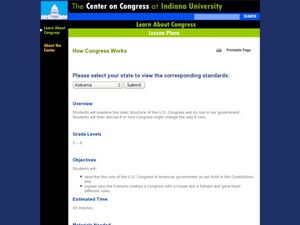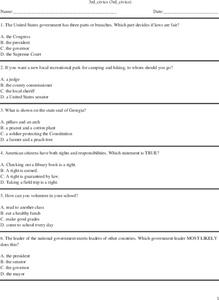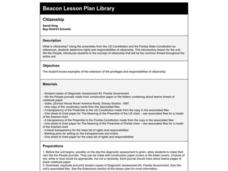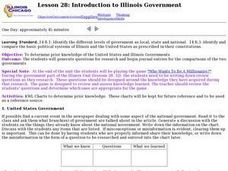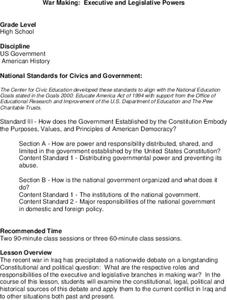Curated OER
The Two-Party System: Chapter 5
Guide your students' reading with this learning exercise. Included are five matching and five multiple choice questions focused on aspects of the two-party system employed in the United States. Use as a quiz, guided reading questions, or...
iCivics
Argument Wars
From start to finish, here is a fantastic resource that uses engaging activities and an interactive virtual game to teach about major US Supreme Court cases. Your class members will distinguish the primary arguments made in such cases as...
Curated OER
How Congress Works
Students describe role of the U.S. Congress in American government as set forth in the Constitution, and explain why the Framers created a Congress with a House and a Senate and gave them different roles.
Curated OER
Launching the New U.S. Navy
Students analyze the U.S. Constitution for references to the creation and management of the U.S. Navy. They discuss their research and complete a worksheet and then research how the current Navy is organized.
Curated OER
Limits of Power
Middle schoolers examine the importance of limiting power in governments. In this government lesson, students investigate the importance of placing limits on government by looking at the US Constitution. They look at ways that being an...
Curated OER
WHO'S IN CHARGE?
Third graders explore the three branches of government, their origins and the purposes of government. Each team develop a PowerPoint presentation of their findings. Stjudents also explore how to be a good citizen.
Curated OER
The Taliban Meets the Bill of Rights
Students contrast the Taliban and the Constitution. They read through "What the Taliban Banned" and identify "rights." They determine if rights in the United States are in danger and if the Taliban violate the first ten amendments to...
Curated OER
Civics Review for Grade 3
In this civics review for grade 3 learning exercise, 3rd graders answer 25 multiple choice questions about U.S. government in standardized test format.
Curated OER
Dekanawidah- A Forgotten Founding Father
Students compare plans for government. In this early American history lesson, students compare and contrast the U.S. Constitution with the Iroquois Constitution. Students identify cultural features, government functions, and citizenship...
Curated OER
Judicial Review
Student demonstrate understanding of both sides of the argument between Jefferson and Marshall that led to the strengthening of the Judicial Branch through the creation of judicial review. Unit is comprised of five lessons and fits into...
Curated OER
Understanding The Preamble
Students explore the Preamble of the U.S. Constitution. In this government lesson plan, students write a preamble to encourage cooperation in their classroom as they study the Preamble of the U.S. Constitution.
Curated OER
Citizenship
Fifth graders read the preamble of the U.S. and Florida Constitutions. They discuss vocabulary definitions surrounding the concept of citizenship. They discuss and write about the rights and responsibilities of citizens and apply their...
Curated OER
Lesson 28: Introduction to Illinois Government
Fourth graders research and compare the United States and Illinois Governments. They play the game Who Wans To Be A Millionaire.
Curated OER
Role Playing Free Speech
Learners conduct research into looking at a free-speech issue. They role play the events surrounding a court case. The lesson includes guiding questions to help create context and determine areas of further study. The presentation...
Curated OER
Supreme Court Decisions on Freedom of Religion
What does freedom of religion mean? Analyze a series of Supreme Court cases where the First Amendment right to freedom of religion was put to the test. They discuss the cases' outcomes and argue whether the right decision was made....
Curated OER
The U.S. and Iroquois Constitutions
Students receive and interpret copies of US Constitution and Iroquois Constitution. Then they reference (look up) the articles mentioned by Daly in the Iroquois Constitution text, and analyze for parallel meaning in the US Constitution....
Curated OER
3 Branches of Governement
Sixth graders use the "Making the Grade" books, citizenship packets, and the "Ben's Guide" website to create a poster and a report on their assigned government branch. They then present their poster and report to their classmates.
Curated OER
War Making: Executive and Legislative Powers
Students examine Constitution and what it says about war-making power, contrast roles and responsibilities of executive and legislative branches of government when it comes to making war, become familiar with important 20th and 21st...
Curated OER
Another King George?
Students study the differences between presidents and kings, and constitutional monarchs and despots. They examine why the US has a president instead of a king.
Curated OER
How Congress Works
Students study the role of the U.S. Congress in American government as described in the Constitution. In this U.S. government lesson, students watch an overhead about 'public criticisms' in the legislative process and complete a quiz....
Curated OER
The Bill of Rights: Debating the Amendments
Students explore the Bill of Rights. In this U.S. Constitution lesson, students participate in classroom debate regarding the first 10 amendments to the Constitution. Students then vote for the amendments they would like to ratify.
Curated OER
Supreme Court June 2010 Decisions Wrap-Up
Learners consider constitutional rights. In this Bill of Rights instructional activity, students complete an activity guide that requires learners to examine Bill of Rights-related cases of 2010. Students respond to discussion questions...
Curated OER
Government Lesson Plan: Lesson Plan 5
High schoolers identify the process of writing a case brief. They analyze the case McCulloch v Maryland. After a lecture/demo, students utilize a case study worksheet imbedded in this plan to help them explain the process of performing a...
Curated OER
U.S. Government & Indian Nations
Students explain the Constitutional basis of the Federal Indian relationship; summarize the Constitutional references to American Indians; and, evaluate the importance of the Northwest Ordinance of 1787.


